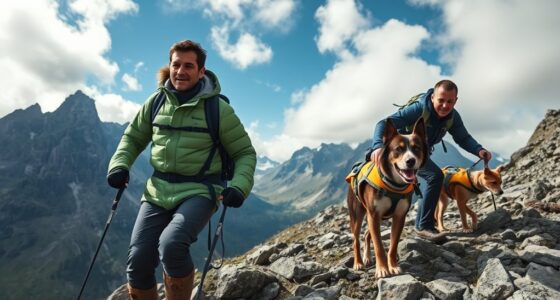When backpacking overnight with your dog, plan routes suited to their age and fitness, and bring plenty of water in collapsible bowls or bottles with built-in dishes. Keep your dog on a leash, carry a first aid kit, and be mindful of hazardous terrain. Respect the environment by packing out waste and avoiding wildlife disturbance. Staying attentive to your dog’s hydration, health, and comfort is key—continue exploring for more tips to make your adventure safer and more enjoyable.
Key Takeaways
- Carry sufficient water and portable dishes, offering regular hydration to prevent dehydration and heat-related issues.
- Research the route for hazards, keep your dog on a leash, and carry a first aid kit for safety.
- Choose trails suitable for your dog’s age, breed, and fitness level, adjusting difficulty accordingly.
- Pack out all waste in biodegradable bags, respecting the environment and local regulations.
- Monitor your dog for signs of fatigue or dehydration, and be ready to shorten the trek if needed.

Have you ever considered how rewarding it can be to explore the great outdoors with your dog? Trekking with your furry companion offers unmatched companionship and adventure, but it also requires careful planning to guarantee both your safety and your dog’s well-being. One of the most important aspects of a successful overnight trek is maintaining proper dog hydration. Dogs can become dehydrated quickly, especially in warm weather or at higher altitudes, so it’s essential to carry enough water for both of you. Bring a collapsible bowl or a portable water bottle with a built-in dish, and make sure to offer your dog water regularly, even if they seem eager to keep moving. Never rely solely on natural water sources without purifying the water first, as streams and ponds can harbor bacteria or parasites that could make your dog sick. Hydration is critical not only for keeping your dog energized but also for preventing heat exhaustion or heatstroke, which can happen rapidly during strenuous hikes. Additionally, understanding your dog’s hydration needs helps ensure they remain healthy and comfortable throughout your trek. Trail safety is another indispensable consideration. Before setting out, research your route thoroughly to understand potential hazards like unstable terrain, wildlife encounters, or sudden weather changes. Keep your dog on a leash or within a secure harness to prevent darting into dangerous areas or disturbing local wildlife. Watch your footing carefully—many trails can be rocky, muddy, or uneven—and be ready to assist your dog over tricky sections. Carry a basic first aid kit tailored for dogs, including bandages, antiseptic wipes, and any medications your dog might need. Recognize signs of distress in your pup, such as excessive panting, limping, or signs of fatigue, and be prepared to cut the trek short if necessary. Additionally, consider your dog’s age, breed, and fitness level when planning your route; what’s manageable for a young, energetic dog might be too strenuous for an older or less agile one. Preparing for trail safety also means respecting the environment and local regulations. Keep your dog under control to prevent wildlife disturbances and avoid leaving waste behind. Pack out all dog waste in biodegradable bags and dispose of it properly. Be mindful of local flora and fauna, especially if your dog has a tendency to chase or dig, which could lead to injury or environmental damage. By prioritizing dog hydration and trail safety, you’ll create a more enjoyable, secure experience for both of you. The effort you invest now ensures that your trek remains fun, safe, and memorable for many adventures to come.
Frequently Asked Questions
How Do I Train My Dog for Overnight Backpacking Trips?
To train your dog for overnight backpacking trips, start by gradually increasing their hiking distances and carrying weight. Focus on proper dog nutrition and hydration strategies, making sure your pup stays energized and hydrated. Practice overnight stays in familiar settings to build confidence. Use positive reinforcement, and make sure your dog’s gear fits well. Consistent training and attention to their needs will prepare your dog for a successful, enjoyable adventure.
What Are the Best Dog-Friendly Trails for Beginners?
You’ll love exploring dog-friendly parks and beginner trail tips that make trekking easier. Look for trails with gentle slopes, wide paths, and shaded areas to keep your dog comfortable. Prioritize parks known for dog-friendly amenities and easy terrain. Stay on marked trails, bring plenty of water, and keep your dog leashed. These simple steps will help you enjoy safe, fun adventures together on beginner-friendly trails.
How Can I Prevent My Dog From Overheating?
To prevent your dog from overheating, keep a close eye on signs like excessive panting or drooling. Use dog cooling methods such as wet towels or cooling vests, and offer plenty of hydration strategies by providing fresh water frequently. Take breaks in shaded areas, avoid peak heat hours, and leash your dog to prevent overexertion. Staying vigilant guarantees a safe, enjoyable adventure for both of you.
What Should I Do if My Dog Gets Injured?
If your dog gets injured, act quickly by evaluating the injury and applying first aid essentials like cleaning wounds, stopping bleeding, and immobilizing broken limbs. Keep calm to prevent further stress, and use a well-stocked first aid kit. To prevent injuries, always check the trail for hazards and keep your dog on a leash. If the injury is severe, seek veterinary help immediately to ensure proper treatment.
Are There Specific Gear Recommendations for Dogs?
You should bring specific gear for your dog, like a sturdy harness, leash, and a collapsible water bowl for dog hydration. Consider a dog-specific backpack for essentials and a first aid kit tailored for trail safety for dogs. Don’t forget to pack extra water and snacks, and check your dog’s paws for rough terrain. Proper gear keeps your dog safe, comfortable, and hydrated during overnight adventures.
Conclusion
Trekking with your dog can be a rewarding adventure, but it’s essential to be prepared. Did you know that over 60% of dog owners take their pets on outdoor excursions? By following these backpacking tips, you’ll guarantee a safe, enjoyable experience for both of you. Remember to pack essentials, stay mindful of your dog’s needs, and respect the environment. With the right planning, your overnight adventure will create unforgettable memories for you and your furry friend.










